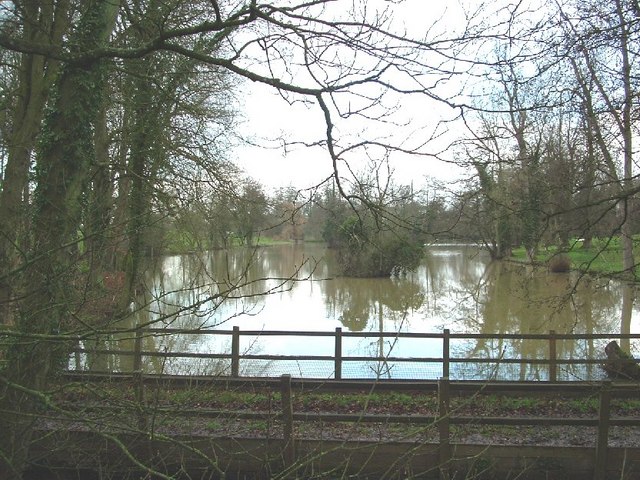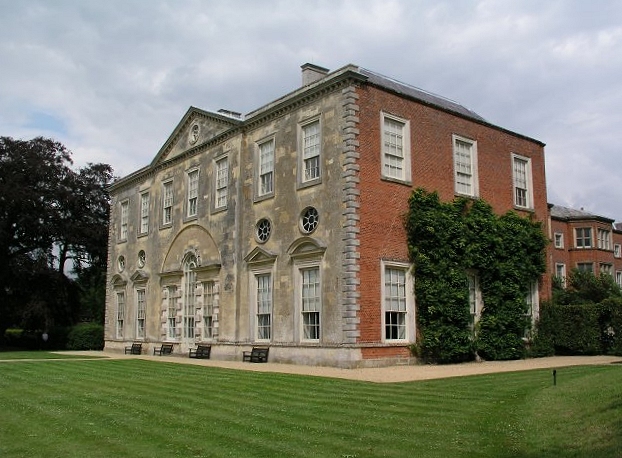|
Biddlesden Park
Biddlesden Park is a country house at Biddlesden in north-west Buckinghamshire. It is a Grade II* listed building. History The house, which lies on the site of an old Cistercian abbey, was built by John Sayer, in the Georgian style in 1727. The staircase dates from the same period. The house then passed to Ralph Verney, 2nd Earl Verney before it was acquired, on Verney's death in 1791, by George Morgan, who was High Sheriff of Buckinghamshire The High Sheriff of Buckinghamshire, in common with other counties, was originally the King's representative on taxation upholding the law in Anglo-Saxons, Saxon times. The word Sheriff evolved from 'shire-reeve'. High Sheriff, Sheriff is the olde .... The house remained in the ownership of the Morgan and then the Morgan-Grenville family for most of the 19th century. It was bought by Lieutenant Colonel Reginald Badger in around 1932 and then remained in the Badger family for many years before passing to Mrs. Elizabeth Maud Gordon. It was the ... [...More Info...] [...Related Items...] OR: [Wikipedia] [Google] [Baidu] |
Biddlesden Park Lake - Geograph
Biddlesden is a village and civil parish in Aylesbury Vale district in north-west Buckinghamshire, England on the boundary with Northamptonshire. It is about east-north-east of Brackley, Northamptonshire and north-west of Buckingham. The River Great Ouse forms part of the western boundary of the parish, separating the village from Northamptonshire. The ancient royal forest of Whittlewood extended to the northern edge of the village. History The village toponym is derived from the Old English for either "house in a valley" or "Byttel's valley". In the Domesday Book of 1086 the village is recorded as ''Betesdene''. In 1147 Ernald de Bosco founded the Cistercian Biddlesden Abbey. In 1315, the village was granted a temporary charter to hold a weekly market. When the abbey was seized on behalf of Henry VIII during the Dissolution of the Monasteries it was assessed to be earning in excess of £175 annually in rents and tithes. Although the abbey continued after this time as ... [...More Info...] [...Related Items...] OR: [Wikipedia] [Google] [Baidu] |
Biddlesden
Biddlesden is a village and civil parish in Aylesbury Vale district in north-west Buckinghamshire, England on the boundary with Northamptonshire. It is about east-north-east of Brackley, Northamptonshire and north-west of Buckingham. The River Great Ouse forms part of the western boundary of the parish, separating the village from Northamptonshire. The ancient royal forest of Whittlewood extended to the northern edge of the village. History The village toponym is derived from the Old English for either "house in a valley" or "Byttel's valley". In the Domesday Book of 1086 the village is recorded as ''Betesdene''. In 1147 Ernald de Bosco founded the Cistercian Biddlesden Abbey. In 1315, the village was granted a temporary charter to hold a weekly market. When the abbey was seized on behalf of Henry VIII during the Dissolution of the Monasteries it was assessed to be earning in excess of £175 annually in rents and tithes. Although the abbey continued after this time as ... [...More Info...] [...Related Items...] OR: [Wikipedia] [Google] [Baidu] |
Buckinghamshire
Buckinghamshire (), abbreviated Bucks, is a ceremonial county in South East England that borders Greater London to the south-east, Berkshire to the south, Oxfordshire to the west, Northamptonshire to the north, Bedfordshire to the north-east and Hertfordshire to the east. Buckinghamshire is one of the Home Counties, the counties of England that surround Greater London. Towns such as High Wycombe, Amersham, Chesham and the Chalfonts in the east and southeast of the county are parts of the London commuter belt, forming some of the most densely populated parts of the county, with some even being served by the London Underground. Development in this region is restricted by the Metropolitan Green Belt. The county's largest settlement and only city is Milton Keynes in the northeast, which with the surrounding area is administered by Milton Keynes City Council as a unitary authority separately to the rest of Buckinghamshire. The remainder of the county is administered by Buck ... [...More Info...] [...Related Items...] OR: [Wikipedia] [Google] [Baidu] |
Listed Building
In the United Kingdom, a listed building or listed structure is one that has been placed on one of the four statutory lists maintained by Historic England in England, Historic Environment Scotland in Scotland, in Wales, and the Northern Ireland Environment Agency in Northern Ireland. The term has also been used in the Republic of Ireland, where buildings are protected under the Planning and Development Act 2000. The statutory term in Ireland is " protected structure". A listed building may not be demolished, extended, or altered without special permission from the local planning authority, which typically consults the relevant central government agency, particularly for significant alterations to the more notable listed buildings. In England and Wales, a national amenity society must be notified of any work to a listed building which involves any element of demolition. Exemption from secular listed building control is provided for some buildings in current use for worship, ... [...More Info...] [...Related Items...] OR: [Wikipedia] [Google] [Baidu] |
Georgian Architecture
Georgian architecture is the name given in most English-speaking countries to the set of architectural styles current between 1714 and 1830. It is named after the first four British monarchs of the House of Hanover—George I, George II, George III, and George IV—who reigned in continuous succession from August 1714 to June 1830. The so-called great Georgian cities of the British Isles were Edinburgh, Bath, pre-independence Dublin, and London, and to a lesser extent York and Bristol. The style was revived in the late 19th century in the United States as Colonial Revival architecture and in the early 20th century in Great Britain as Neo-Georgian architecture; in both it is also called Georgian Revival architecture. In the United States the term "Georgian" is generally used to describe all buildings from the period, regardless of style; in Britain it is generally restricted to buildings that are "architectural in intention", and have stylistic characteristics that are typical o ... [...More Info...] [...Related Items...] OR: [Wikipedia] [Google] [Baidu] |
Ralph Verney, 2nd Earl Verney
Ralph Verney, 2nd Earl Verney PC, FRS (1 February 1714 – 31 March 1791), was a member of the Verney family of Middle Claydon and a British politician. From 1737 until 1752, when he succeeded to the earldom, he was styled Lord Fermanagh. He sat in the House of Commons several times between 1753 and 1791. Life Verney was born on 1 February 1714, the son of Ralph Verney, the first Earl Verney, of Claydon House, Buckinghamshire; and Catherine, daughter to Henry Paschall of Baddow Hall in Essex. In 1740 he married Mary, daughter of Henry Herring, a director of the Bank of England. They had no children. She died on 22 January 1791, and Verney died on 31 March of the same year; both were buried in the family vault in the church of Middle Claydon. He left debts of over £115,000. His various titles were extinguished at his death. His estates were inherited by Mary Verney, the daughter of his elder brother John, who had died in 1737. At the recommendation of William Pitt, ... [...More Info...] [...Related Items...] OR: [Wikipedia] [Google] [Baidu] |
High Sheriff Of Buckinghamshire
The High Sheriff of Buckinghamshire, in common with other counties, was originally the King's representative on taxation upholding the law in Anglo-Saxons, Saxon times. The word Sheriff evolved from 'shire-reeve'. High Sheriff, Sheriff is the oldest Secularity, secular office under the Crown. Formerly the sheriff was the principal law enforcement officer in the county but over the centuries most of the responsibilities associated with the post have been transferred elsewhere or are now defunct, so that its functions are now largely ceremonial. Under the provisions of the Local Government Act 1972, on 1 April 1974 the office previously known as Sheriff was retitled High Sheriff. The title of High Sheriff#United Kingdom, sheriff is therefore much older than the other Crown appointment, the Lord Lieutenant of Buckinghamshire, which came about in 1535. Unlike the Lord Lieutenant of Buckinghamshire, which is generally held from appointment until the holder's death or incapacity, the t ... [...More Info...] [...Related Items...] OR: [Wikipedia] [Google] [Baidu] |



